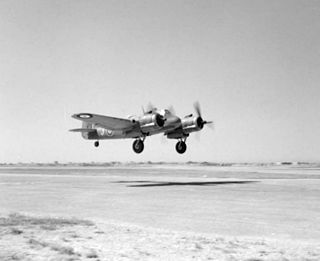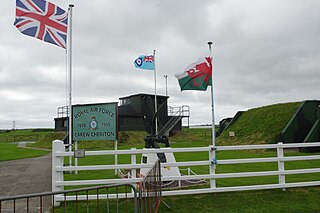
The Bristol Type 156 Beaufighter is a British multi-role aircraft developed during the Second World War by the Bristol Aeroplane Company. It was originally conceived as a heavy fighter variant of the Bristol Beaufort torpedo bomber. The Beaufighter proved to be an effective night fighter, which came into service with the Royal Air Force (RAF) during the Battle of Britain, its large size allowing it to carry heavy armament and early aircraft interception radar without major performance penalties.

No. 206 Squadron is a Test and Evaluation Squadron of the Royal Air Force. Until 2005 it was employed in the maritime patrol role with the Nimrod MR.2 at RAF Kinloss, Moray. It was announced in December 2004 that 206 Squadron would disband on 1 April 2005, with half of its crews being redistributed to Nos. 120 and 201 Squadrons, also stationed at Kinloss. This was a part of the UK Defence Review called Delivering Security in a Changing World; the Nimrod MR.2 fleet was reduced in number from 21 to 16 as a consequence.

Number 47 Squadron is an inactive squadron of the Royal Air Force. Previously based at RAF Brize Norton, Oxfordshire, it last operated the Lockheed Martin Hercules C4/C5 between 2013 and 2023. It previously flew the Lockheed Hercules C.1/C.3 between 1968 and 2013.

No. 220 Squadron of the Royal Air Force (RAF) was founded in 1918 and disbanded in 1963 after four separate periods of service. The squadron saw service in both the First and Second World Wars, as a maritime patrol unit, and finally as part of Britain's strategic nuclear deterrent.

No. 489 (NZ) Squadron was a torpedo bomber squadron established for service during the Second World War. It was a New Zealand squadron formed under Article XV of the Empire Air Training Plan. Although its flying personnel were largely drawn from the Royal New Zealand Air Force, the squadron served in Europe under the operational and administrative command of the Royal Air Force as part of Coastal Command.
No. 119 Squadron RAF was a squadron of the Royal Air Force (RAF), flying with Coastal Command during the Second World War. It was the only RAF unit flying the Short G class and Short C class flying boats.

No. 257 Squadron RAF was a flying squadron of the Royal Air Force active during the First World War, the Second World War and also the Cold War. It was finally disbanded in December 1963.

No. 455 Squadron was a Royal Australian Air Force (RAAF) torpedo bomber squadron during World War II and became famous as part of the "ANZAC Strike Wing" that was formed from Australian and New Zealand squadrons. Raised in early 1941, mainly from Australian personnel, the squadron served over Europe during the war, operating from various bases in the United Kingdom; it also briefly sent a detachment to the Soviet Union in 1942. Operating Handley Page Hampdens and Bristol Beaufighters, the squadron mainly undertook anti-shipping and anti-submarine operations during the war. It was disbanded in May 1945 following the cessation of hostilities against Germany.

No. 500 Squadron AAF was a Royal Air Force flying squadron. It was initially formed in 1931 as a Special Reserve squadron and in 1936 became part of the Auxiliary Air Force, at this time based at Manston and Detling.

No. 235 Squadron RAF was an anti-submarine warfare squadron of the Royal Air Force which disbanded during July 1945. It was active in both the First World War, forming during August 1918 and disbanding in February 1919, and in the Second World War, reforming at the end of October 1939, and served as a squadron in RAF Coastal Command.

No. 239 Squadron RAF was an anti-submarine squadron of the Royal Air Force during World War I. During World War II the squadron performed as an army co-operation squadron and later as a night intruder unit. After the war the squadron was disbanded.

No. 502 (Ulster) Squadron was a Royal Auxiliary Air Force squadron that saw service in World War II. It was reformed in September 2013, and is the oldest of all the reserve squadrons, being formed in 1925.

Number 209 Squadron of the British Royal Air Force was originally formed from a nucleus of "Naval Eight" on 1 February 1917 at Saint-Pol-sur-Mer, France, as No. 9 Squadron Royal Naval Air Service (RNAS) and saw active service in both World Wars, the Korean War and in Malaya. The use of the squadron number ceased in 1968 and it has not been reused since by an RAF squadron. However the number, badge and motto is in current service within the RAF Air Cadets at 209 Squadron ATC in Nottinghamshire.

Royal Air Force Talbenny, or more simply RAF Talbenny, is a former Royal Air Force station located 5.6 miles (9.0 km) north west of Milford Haven, Pembrokeshire and 7.9 miles (12.7 km) south west of Haverfordwest, Pembrokeshire, Wales.

Royal Air Force Carew Cheriton, or more simply RAF Carew Cheriton, is a former Royal Air Force station located near Carew, Pembrokeshire. It was situated 4.7 miles (7.6 km) north west of Tenby.

Royal Air Force Thorney Island, or more simply RAF Thorney Island, is a former Royal Air Force station located on Thorney Island, West Sussex, England, 6.6 miles (10.6 km) west of Chichester and 7.1 miles (11.4 km) east of Portsmouth, Hampshire.

No. 217 Squadron RAF was a squadron of the RAF. It was formed and disbanded four times between 1 April 1918 and 13 November 1959. In World War I it served in a strike role against enemy bases and airfields in Belgium. In World War II as part of RAF Coastal Command it served first in a maritime patrol role along the Western Approaches and later in an anti-shipping role in the English Channel. Ordered to the Far East in 1942, the squadron was retained for two months in Malta in an anti-shipping role, protecting Allied convoys, before moving to Ceylon to defend the approaches to India, serving in an anti-submarine and anti-shipping role. It was equipped and training for a strike role, when the war ended. In the postwar period, it served for five years in a maritime reconnaissance role, and then briefly in a support role for Operation Grapple, the British hydrogen bomb tests on Christmas Island.
No. 248 Squadron was a squadron of the Royal Air Force, active immediately after World War I, and again during World War II.
No. 240 Squadron RAF was a Royal Air Force flying boat and seaplane squadron during World War I, World War II and up to 1959. It was then reformed as a strategic missile squadron, serving thus till 1963.
No. 143 Squadron RAF was a Royal Air Force Squadron formed as a fighter unit in the First World War and reformed as an RAF Coastal Command fighter and anti-submarine unit in the Second World War.















